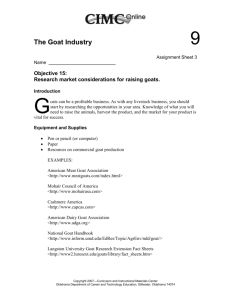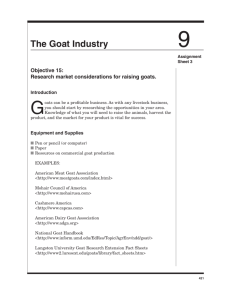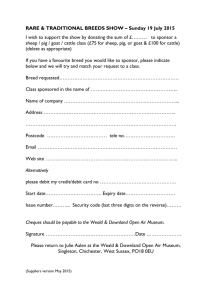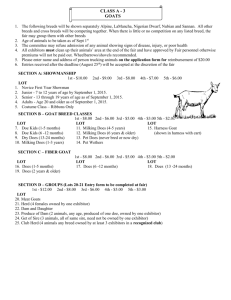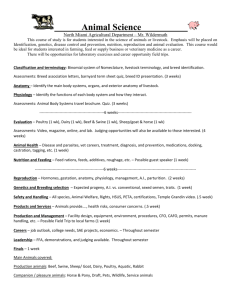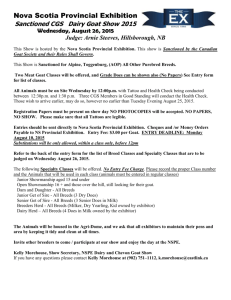Carcass Characteristics of the Libyan Purebred Mahali
advertisement
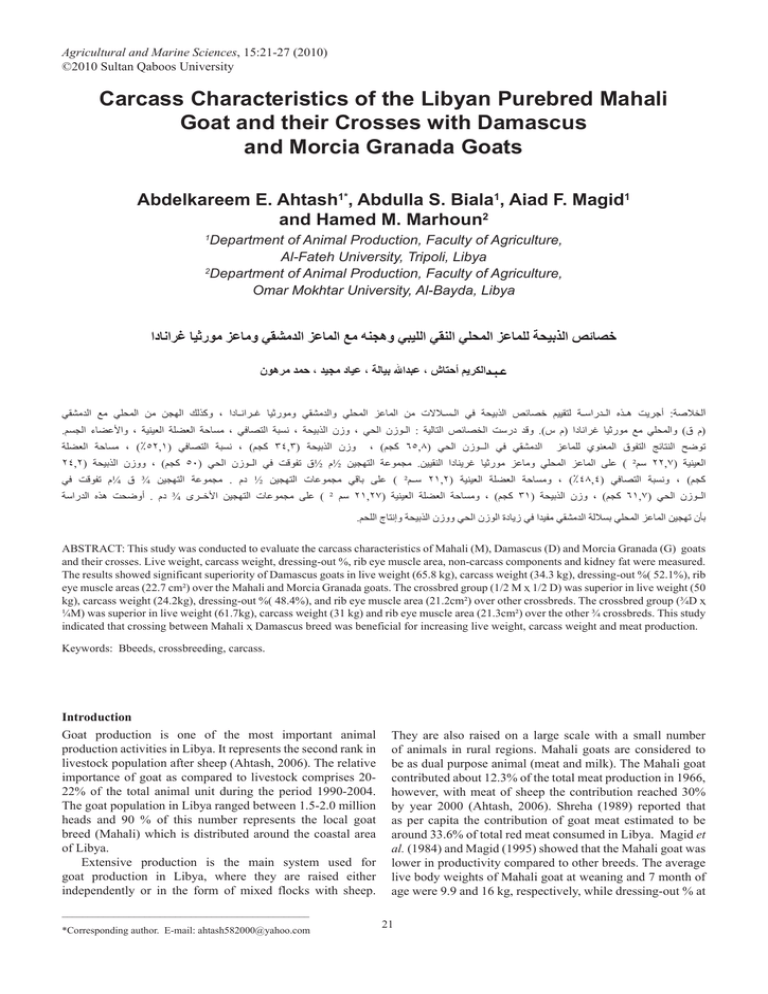
Agricultural and Marine Sciences, 15:21-­27 (2010) ©2010 Sultan Qaboos University Carcass Characteristics of the Libyan Purebred Mahali Goat and their Crosses with Damascus and Morcia Granada Goats Abdelkareem E. Ahtash1*, Abdulla S. Biala1, Aiad F. Magid1 and Hamed M. Marhoun2 Department of Animal Production, Faculty of Agriculture, Al-­Fateh University, Tripoli, Libya 2 Department of Animal Production, Faculty of Agriculture, Omar Mokhtar University, Al-­Bayda, Libya 1 ﻭوﻣﺎﻋﺰ ﻣﻮﺭرﺛﻴﯿﺎ ﻏﺮﺍاﻧﺎﺩدﺍا ﺍاﻟﻤﺤﻠﻲ ﺍاﻟﻨﻘﻲ ﺍاﻟﻠﻴﯿﺒﻲ ﻭوﻫﮬﮪھﺠﻨﻪﮫ ﻣﻊ ﺍاﻟﻤﺎﻋﺰ ﺍاﻟﺪﻣﺸﻘﻲ ﺧﺼﺎﺋﺺ ﺍاﻟﺬﺑﻴﯿﺤﺔ ﻟﻠﻤﺎﻋﺰ ﺣﻤﺪ ﻣﺮﻫﮬﮪھﻮﻥن ،٬ ﻋﻴﯿﺎﺩد ﻣﺠﻴﯿﺪ،٬ ﻋﺒﺪﺍاﷲ ﺑﻴﯿﺎﻟﺔ،٬ ﺃأﺣﺘﺎﺵش ﻋﺒﺪﺍاﻟﻜﺮﻳﯾﻢ ﺍاﻟﺪﻣﺸﻘﻲ ﺍاﻟﻤﺤﻠﻲ ﻣﻊ ﻭوﻛﺬﻟﻚ ﺍاﻟﻬﮭﺠﻦ ﻣﻦ ،٬ ﻏــﺮﺍاﻧــﺎﺩدﺍا ﺍاﻟﺬﺑﻴﯿﺤﺔ ﻓﻲ ﺍاﻟــﺴــﻼﻻﺕت ﻣﻦ ﺍاﻟﻤﺎﻋﺰ ﺍاﻟﻤﺤﻠﻲ ﻭوﺍاﻟﺪﻣﺸﻘﻲ ﻭوﻣﻮﺭرﺛﻴﯿﺎ ﺧﺼﺎﺋﺺ ﺍاﻟــﺪﺭرﺍاﺳــﺔ ﻟﺘﻘﻴﯿﻴﯿﻢ ﺃأﺟﺮﻳﯾﺖ ﻫﮬﮪھــﺬﻩه:ﺍاﻟﺨﻼﺻﺔ . ﻭوﺍاﻷﻋﻀﺎء ﺍاﻟﺠﺴﻢ ،٬ ﻣﺴﺎﺣﺔ ﺍاﻟﻌﻀﻠﺔ ﺍاﻟﻌﻴﯿﻨﻴﯿﺔ،٬ ﻧﺴﺒﺔ ﺍاﻟﺘﺼﺎﻓﻲ،٬ ﻭوﺯزﻥن ﺍاﻟﺬﺑﻴﯿﺤﺔ،٬ ﺍاﻟــﻮﺯزﻥن ﺍاﻟﺤﻲ: ﻭوﻗﺪ ﺩدﺭرﺳﺖ ﺍاﻟﺨﺼﺎﺋﺺ ﺍاﻟﺘﺎﻟﻴﯿﺔ.( ﻕق( ﻭوﺍاﻟﻤﺤﻠﻲ ﻣﻊ ﻣﻮﺭرﺛﻴﯿﺎ ﻏﺮﺍاﻧﺎﺩدﺍا )ﻡم ﺱس )ﻡم ﻣﺴﺎﺣﺔ ﺍاﻟﻌﻀﻠﺔ،٬ (٪٥٢۲,١۱) ﻧﺴﺒﺔ ﺍاﻟﺘﺼﺎﻓﻲ،٬ ( ﻛﺠﻢ ٣۳٤,٣۳) ﺍاﻟﺬﺑﻴﯿﺤﺔ ﻭوﺯزﻥن ،٬ ( ﻛﺠﻢ٦٥,٨۸) ﺍاﻟﺪﻣﺸﻘﻲ ﻓﻲ ﺍاﻟــﻮﺯزﻥن ﺍاﻟﺤﻲ ﺗﻮﺿﺢ ﺍاﻟﻨﺘﺎﺋﺞ ﺍاﻟﺘﻔﻮﻕق ﺍاﻟﻤﻌﻨﻮﻱي ﻟﻠﻤﺎﻋﺰ ٢۲٤,٢۲) ﻭوﻭوﺯزﻥن ﺍاﻟﺬﺑﻴﯿﺤﺔ ،٬ ( ﻛﺠﻢ٥٠۰) ﺍاﻟــﻮﺯزﻥن ﺍاﻟﺤﻲ ½ﻡم ½ﻕق ﺗﻔﻮﻗﺖ ﻓﻲ ﻣﺠﻤﻮﻋﺔ ﺍاﻟﺘﻬﮭﺠﻴﯿﻦ. ﺍاﻟﻨﻘﻴﯿﻴﯿﻦ ﻣﻮﺭرﺛﻴﯿﺎ ﻏﺮﻳﯾﻨﺎﺩدﺍا ﻭوﻣﺎﻋﺰ ﺍاﻟﻤﺎﻋﺰ ﺍاﻟﻤﺤﻠﻲ ( ﻋﻠﻰ² ﺳﻢ٢۲٢۲,٧۷) ﺍاﻟﻌﻴﯿﻨﻴﯿﺔ ¼ﻡم ﺗﻔﻮﻗﺖ ﻓﻲ ﻣﺠﻤﻮﻋﺔ ﺍاﻟﺘﻬﮭﺠﻴﯿﻦ ¾ ﻕق. ( ﻋﻠﻰ ﺑﺎﻗﻲ ﻣﺠﻤﻮﻋﺎﺕت ﺍاﻟﺘﻬﮭﺠﻴﯿﻦ ½ ﺩدﻡم² ﺳــﻢ٢۲١۱,٢۲) ﻭوﻣﺴﺎﺣﺔ ﺍاﻟﻌﻀﻠﺔ ﺍاﻟﻌﻴﯿﻨﻴﯿﺔ،٬ (٪٤٨۸,٤) ﻭوﻧﺴﺒﺔ ﺍاﻟﺘﺼﺎﻓﻲ،٬ (ﻛﺠﻢ ﺃأﻭوﺿﺤﺖ ﻫﮬﮪھﺬﻩه ﺍاﻟﺪﺭرﺍاﺳﺔ. ﺩدﻡم ¾ ﻋﻠﻰ ﻣﺠﻤﻮﻋﺎﺕت ﺍاﻟﺘﻬﮭﺠﻴﯿﻦ ﺍاﻷﺧــﺮﻯى ( ² ﺳﻢ ٢۲١۱,٢۲٧۷) ﺍاﻟﻌﻴﯿﻨﻴﯿﺔ ﺍاﻟﻌﻀﻠﺔ ﻭوﻣﺴﺎﺣﺔ،٬ ( ﻛﺠﻢ٣۳١۱) ﻭوﺯزﻥن ﺍاﻟﺬﺑﻴﯿﺤﺔ،٬ ( ﻛﺠﻢ٦١۱,٧۷) ﺍاﻟــﻮﺯزﻥن ﺍاﻟﺤﻲ . ﺍاﻟﺬﺑﻴﯿﺤﺔ ﻭوﺇإﻧﺘﺎﺝج ﺍاﻟﻠﺤﻢ ﺑﺄﻥن ﺗﻬﮭﺠﻴﯿﻦ ﺍاﻟﻤﺎﻋﺰ ﺍاﻟﻤﺤﻠﻲ ﺑﺴﻼﻟﺔ ﺍاﻟﺪﻣﺸﻘﻲ ﻣﻔﻴﯿﺪﺍا ﻓﻲ ﺯزﻳﯾﺎﺩدﺓة ﺍاﻟﻮﺯزﻥن ﺍاﻟﺤﻲ ﻭوﻭوﺯزﻥن ABSTRACT: This study was conducted to evaluate the carcass characteristics of Mahali (M), Damascus (D) and Morcia Granada (G) goats and their crosses. Live weight, carcass weight, dressing-­out %, rib eye muscle area, non-­carcass components and kidney fat were measured. The results showed significant superiority of Damascus goats in live weight (65.8 kg), carcass weight (34.3 kg), dressing-­out %( 52.1%), rib eye muscle areas (22.7 cm²) over the Mahali and Morcia Granada goats. The crossbred group (1/2 M ҳ 1/2 D) was superior in live weight (50 kg), carcass weight (24.2kg), dressing-­out %( 48.4%), and rib eye muscle area (21.2cm²) over other crossbreds. The crossbred group (¾D ҳ ¼M) was superior in live weight (61.7kg), carcass weight (31 kg) and rib eye muscle area (21.3cm²) over the other ¾ crossbreds. This study indicated that crossing between Mahali ҳ Damascus breed was beneficial for increasing live weight, carcass weight and meat production. Keywords: Bbeeds, crossbreeding, carcass. Introduction Goat production is one of the most important animal production activities in Libya. It represents the second rank in livestock population after sheep (Ahtash, 2006). The relative importance of goat as compared to livestock comprises 20-­ 22% of the total animal unit during the period 1990-­2004. The goat population in Libya ranged between 1.5-­2.0 million heads and 90 % of this number represents the local goat breed (Mahali) which is distributed around the coastal area of Libya. Extensive production is the main system used for goat production in Libya, where they are raised either independently or in the form of mixed flocks with sheep. They are also raised on a large scale with a small number of animals in rural regions. Mahali goats are considered to be as dual purpose animal (meat and milk). The Mahali goat contributed about 12.3% of the total meat production in 1966, however, with meat of sheep the contribution reached 30% by year 2000 (Ahtash, 2006). Shreha (1989) reported that as per capita the contribution of goat meat estimated to be around 33.6% of total red meat consumed in Libya. Magid et al. (1984) and Magid (1995) showed that the Mahali goat was lower in productivity compared to other breeds. The average live body weights of Mahali goat at weaning and 7 month of age were 9.9 and 16 kg, respectively, while dressing-­out % at ________________________________________________ *Corresponding author. E-­mail: ahtash582000@yahoo.com 21 Ahtash and others 7, 10, 12 months of age were 46%, 52%, 49%, respectively (Magid, 1987). Damascus and Morcia Granada goat breeds were therefore, imported for crossing with Mahali goats to improve its low productivity. The main objective of this study was to evaluate carcass characteristics of Mahali goat and their crosses with Damascus and Morcia Granada goats. Materials and Methods Location The study was conducted in Bir-­Elghanem Research Station (south west of Tripoli) under the authority of Animal Wealth Research Center. The region is classified as semi-­arid, and characterized by rainy winter and dry summer. The ambient air temperature ranges from 9-­42oC and the relative humidity between 63-­81% with annual precipitation between 190-­350 mm. Flock Management Intensive close system was practiced at Bir-­Elghanem station, the animals were raised under half-­opened yard, and the water was available ad-­libitum. The average quantity of concentrate was 0.5-­1.0 kg /head/ day, and the roughages ranged 1.0-­1.5 kg/head/day. [Mahali (M), Damascus (D) and Morcia Granada (G)], first crosses generation (M ҳ D, D ҳ M,M ҳ G and G ҳ M) and second crosses generation [ ¾M ҳ ¼D, ¾D ҳ ¼M and ¾M ҳ ¼G]. The animals were fastened for 24 hrs and weighed prior to slaughter. The weights of carcass, head, legs, skin, empty rumen, intestine, kidney, heart, spleen, kidney fat, abdominal fat, and Longissimus eye muscle area were recorded. Statistical Analysis Statistical analyses were carried out using analysis of variance producers (SAS, 1998) to evaluate the effect of breed and their crossing on carcass characteristics. Carcass characteristics were analyzed for the fixed effect, where the model used included the effect of breeding group on all carcass characters. Duncan’s multiple range tests was used to test the significance of difference among least square means. Results and Discussion The results showed significant effect of breeding group on all traits studied except omental and mesenteric fat weights. Live and Slaughter Weights and Dressing % The results showed that breeding group had highly Carcass Evaluation significant (P<0.01) effect on live and slaughter weight Thirty-­eight bucks at 14 month age were randomly and dressing % (Table 1). The Damascus goat breed is selected for carcass evaluation. These bucks belong to superior in live weight, slaughter weight and dressing % 10 breeding groups that represents three pure goat breeds when compared to the other pure and crossbred groups. Table 1. Least squares means ± S.E. of live weight (kg), slaughter weight (kg) and dressing % of kids in breeding groups. Trait S.V No. Breeding group Live weight (kg) Slaughter weight (kg) Dressing (%) ** ** ** DD 4 65.8 ± 2.2 34.3 ±1.13 52.1± 0.9 a MM 3 38.8 ± 2.5 cd 19.0 ± 1.31 cd 48.9± 1.1 bc GG 4 33.6 ± 2.2 d 16.3 ± 1.13 d 48.0± 0.9 bc ½M½D 4 50.0 ± 2.2 b 24.2 ± 1.13 b 48.4± 0.9 bc ½D½M 4 48.0 ± 2.2 b 22.4 ± 1.13 bc 46.7± 0.9 c ½M½G 4 34.2 ± 2.2 d 16.3 ± 1.13 d 47.5± 0.9 bc ½G½M 4 40.2 ± 2.2 cd 19.1 ± 1.13 cd 47.4± 0.9 bc ¾M¼D 4 44.4 ± 2.2 bc 22.1 ± 1.13 bc 50.3± 0.9 ab ¾D¼M 4 61.7 ± 2.2 a 31.0 ± 1.13 a 50.1± 0.9 abc ¾M¼G 3 40.3 ± 2.5 cd 19.3 ± 1.31 cd 47.9± 1.1 bc 46.1 ± 1.8 22.6 ± 1.01 48.8± 0.4 Average mean a a ** : P<0.01. Means with same letters in the same column, do not differ significantly. Goat breeds: M: Mahali;; D: Damascus;; G: Morcia Granada (G) 22 Carcass characteristics of the Libyan purebred Mahali goat and their crosses with Damascus and Morcia Granada goats The average live weight, slaughter weight and dressing % of pure Damascus were 65.8kg, 34.3kg and 52.1%, respectively. Whereas, the average of the same traits in Mahali were 38.8kg, 19kg and 48.9% and for Morcia Granada were 33.6kg, 16.3kg and 48%. The dressing percentage of Mahali goat in this study was in agreement with that recorded by Biala et al. (1999) in their study with the same breed where they found the dressing % was 49%. While the dressing % of Damascus goat was 49.9% as reported by Shaker et al. (1985), which was lower than that obtained in this study, Aboul-­Naga, (1984) reported a significant effect of breed on live weight of Barki goat and ½Shami½Barki at an age of 8 months. The average live weight of Mahali goat in this study was greater than that reported by Biala et al. (1999) which was 33 kg at 13 months of age. It is obvious from Table 1 that the crosses of Mahali with Damascus had the highest live weight, slaughter weight and dressing % compared to the crossbred of Mahali with Morcia Granada, which reflects the great growth potentiality of Damascus breed in comparison with Morcia Granada breed. The average live weight, slaughter weight and dressing % of the Crossbred ¾ D¼M were 61.7 kg, 31 kg and 50.1 %, respectively. These values were not significantly different from values obtained by the purebred Damascus goat. The crossbred ½M½D and ½D½M differ significantly (P<0.01) in live weight, slaughter weight and dressing % (50kg, 24.2kg, 48.4% and 48 kg, 22.4kg, 46.7% in respective order) from the purebred Damascus and Mahali goats. The crossbred of Mahali with Morcia Granada (½M½G) showed the lowest live weight and slaughter weight compared with other crossbred groups, however, it was not significantly different from both pure breeds (M and G). This indicates the inferiority of the Morcia Granada breed to improve meat production. These results were in agreement with the study of Abdelsalam et al. (1994) who found that the body weight of crossbred Damascus X Barki kids was intermediate between those of their purebred parents. Abdelsalam et al. (2000) reported that the Damascus breed sired Barki goats produced a heavier litter and the crossbred exceeded the Barki in milk yield and litter weight. Al-­Ojaili (1995) concluded that crossbreeding of Dhofari goats with a temperate breed (Anglo-­Nubian) was beneficial for increasing meat production in Oman. Misra (1983) evaluated kids of the Black Bengal, Jamunapari and Beetal breeds and their crosses;; they concluded that the large breeds have potential merit for improving meat production in small and medium sized goat breeds in India. In his study with Spanish goats and their cross with the Boer goat breed. Oman et al. (1999) found that the crossbred was greater in live weight than Spanish goat breed. The results obtained by Mia et al. (1993) in their study with different breeds (Black Bengal, Barbari and Anglo-­Nubian, and Barbari Black Bengal cross) showed that the body weight of crossbred kids remained intermediate to kids of their purebred parents. Mioc et al. (2001) reported a significant difference in dressing % due 23 to the difference in breeds. It was shown that with an increase in body weight the dressing % increased (Dhanda et al., 2003). The half bred groups from Mahali with both Damascus and Morcia Granada did not differ significantly;; however, ½D½M had the lowest dressing % (46.7%). The hybrid groups ¾M’¼D and ¾D¼M had a higher dressing percentage (50.3 and 50.1%, respectively) than the half bred groups, although the difference was not significant. The differences among crossing groups in dressing % could be referred to the difference of the stomach and intestine content at time of slaughtering (Van Niekerk and Casey, 1998). Rib Eye Muscle Areas A highly significant effect of breeding groups (P<0.01) on rib eye muscle areas was found. As shown in Table 2, the Damascus goat had the greatest rib eye muscle areas (22.7 cm²), while the Mahali goat had the lowest one (14.4 cm²) and the Morcia Granada breed was intermediate in this trait (18.7 cm²). The half-­bred of Mahali with Damascus goats was superior in this trait among half-­bred of Mahali with Morcia Granada, the same trend is found with ¾D¼M crossbred. It is obvious that this trait was improved in Mahali goats by crossbreeding with the Damascus goat breed. The variation in rib eye muscle areas resulted from the differences in live weight of crossing groups (Kadim et al., 2003). The authors found in their study of three Omani breeds, that the green mountain goat had the greatest rib eye muscle areas (130 mm²) compared with Dhofari breed (119 mm²) and Batina breed ( 106 mm²). Oman et al. (2000) reported that Angora kids had significantly smaller longissimus muscle area compared to Spanish, Boer x Spanish and Spanish x Angora kids. Edible Parts, Kdney and Spleen Weight Table 2 shows the significant effect of crossing group (P<0.01) on edible parts, kidney and spleen weights. Damascus goat breed exceeded (2.43 kg) the pure breed of Mahali and Morcia Granada goat on edible parts weight (1.41 kg and 1.31 kg respectively). Half bred of Mahali with Damascus goats and ¾D¼M crossbred were superior on edible parts weight compared with ½M½D and ¾M¼G. Results reflect the influence of large live body weight of the Damascus breed among the other breeds. Edible parts expressed as a percentage of carcass empty weight for Damascus, Mahali and Morcia Granada were 3.91%, 3.9% and 4.23% respectively. Wahid et al. (1985) reported differences on edible parts weight due to crossing that affects live weight. The results of this study were in agreement with the study of Mioc et al. (2001) who found a significant effect of breed (P<0.05) on edible parts weight, where the Alpine goat exceeded the Sannen breed on this trait. The same trend was found with kidney and spleen weight, where the Damascus purebred and ¾D¼M crossbred goat had the heaviest weight of kidney compared Ahtash and others Table 2. Least squares means ± S.E. for rib muscle area (cm²), edible parts (kg), kidney weight (kg) and spleen weight (g) of kids in breeding groups. Trait S.V No. Rib muscle area (cm²) ** ** ** ** DD 4 22.7 ± 1.3 a 2.43 ± 0.07 a 175.0 ± 6.9 a 112.5 ± 7.8 a MM 3 14.4 ± 1.5 d 1.41 ± 0.08 de 101.6 ± 7.9 cd 41.6 ± 9.0 d GG 4 18.7 ± 1.3 abc 1.31 ± 0.07 e 118.8 ± 6.9 bc 56.3 ± 7.8 bcd ½M½D 4 21.2 ± 1.3 ab 1.86 ± 0.07 c 137.5 ± 6.9 b 62.5 ± 7.8 bcd ½D½M 4 20.7 ± 1.3 abc 1.76 ± 0.07 c 131.2 ± 6.9 b 68.8 ± 7.8 bc ½M½G 4 16.3 ± 1.3 cd 1.30 ± 0.07 e 87.5 ± 6.9 d 49.2 ± 7.8 cd ½G½M 4 17.6 ± 1.3 bcd 1.51 ± 0.07 de 137.5 ± 6.9 b 68.7 ± 7.8 bc ¾M¼D 4 17.8 ± 1.3 bcd 1.60 ± 0.07 cd 137.5 ± 6.9 b 81.2 ± 7.8 b ¾D¼M 4 21.3 ± 1.3 ab 2.18 ± 0.07 b 156.2 ± 6.9 a 81.2 ± 7.8 b ¾M¼G 3 20.4 ± 1.5 1.63 ± 0.08 125.0 ± 7.9 66.6 ± 9.0 bcd 19.2 ± 0.5 1.71 ± 0.06 131.7 ± 4.4 69.7 ± 3.8 Breeding group Edible parts (kg)δ abc Average mean Kidney weight (g) cd b Spleen weight (g) ** : P<0.01 Means with same letters in the same column, do not differ significantly. Goat breeds: M: Mahali;; D: Damascus;; G: Morcia Granada (G) δ edible parts=heart, liver and lung weights. with Mahali and the Morcia Granada. The heaviest spleen weight recorded on Damascus purebred, ¾D¼M and ¾M¼D crossbred compared with other purebred and crossbred groups. Mahali and Morcia Granada goats did not differ significantly in the weight of both kidney and spleen. This finding was in agreement with the study of Shaker and Masry (1983), who reported the significant effect of crossing groups on kidney weight. The variation in the kidney and spleen weight could be due to differences in slaughter weight (Dhanda et al., 2003). Stomach and Intestine Weights Results show the significant effects (P<0.01) of breeding group on stomach and intestine weights (Table 3). There is Table 3. Least squares means ± S.E. for stomach and intestine weight (kg), weight of fat around the stomach and intestine (g) and weight of fat around the kidney of kids in breeding groups. Trait S.V No. Breeding group Stomach and intestine (kg) Fat around stomach and intestine (g) Fat around kidney (g) ** ns * DD 4 4.7 ± 0.2 793.8 ±170.7 MM 3 2.9 ± 0.23 cd 783.3 ± 197.1 a 133.3 ± 96.2c GG ½M½D 4 4 cd 2.9 ± 0.2 3.9 ± 0.2 b a 550.0 ± 170.7 737.5 ± 170.7 a 112.5 ± 83.3c 337.5 ± 83.3 b ½D½M 4 3.3 ± 0.2 c 712.5 ± 170.7 a 325.0 ± 83.3 b ½M½G 4 2.4 ± 0.2 d 650.0 ± 170.7 a 231.2 ± 83.3c ½G½M 4 3.0 ± 0.2 cd 975.0 ± 170.7 a 475.0 ± 83.3 a ¾M¼D 4 3.1 ± 0.2 c 762.5 ± 170.7 a 387.5 ± 83.3 b ¾D¼M ¾M¼G Average mean 4 3 4.0 ± 0.2 3.1 ± 0.23 c 3.4 ± 0.12 987.5 ± 170.7 833.0 ± 197.1 a 776.9 ± 52.7 362.5 ± 83.3 b 391.6 ± 96.2 b 315.8 ± 29.6 a b a 375.0 ± 83.3 b a ns = non signifiant: P>0.05;; * : P<0.05;; ** : P<0.01 Means with same letters in the same column, do not differ significantly. Goat breeds: M: Mahali;; D: Damascus;; G: Morcia Granada (G) 24 Carcass characteristics of the Libyan purebred Mahali goat and their crosses with Damascus and Morcia Granada goats Table 4. Least squares mean ± S.E. for head legs and hide weight (kg) of kids in breeding groups. Trait S.V No. Breeding group head weight (kg) legs weight (kg) Hide weight (kg) ** ** ** DD 4 4.3 ± 0.14 a 1.71 ± 0.10 a 5.10 ± 0.20 a MM 3 2.6 ± 0.17cd 0.91 ± 0.12 d 2.65 ± 0.23 ef GG 4 2.5 ± 0.14 d 1.03 ± 0.10 cd 2.05 ± 0.20 f ½M½D 4 3.4 ± 0.14 b 1.28 ± 0.10 bc 3.70 ± 0.20 c ½D½M 4 3.4 ± 0.14 b 1.24 ± 0.10 bc 3.45 ± 0.02 cd ½M½G 4 2.4 ± 0.14 d 0.83 ± 0.10 d 2.47 ± 0.20 ef ½G½M 4 2.7 ± 0.14 cd 0.91 ± 0.10 d 2.58 ± 0.20 ef ¾M¼D 4 3.1 ± 0.14 bc 1.13 ± 0.10 cd 3.00 ± 0.20 de ¾D¼M 4 4.0 ± 0.14 a 1.50 ± 0.10 ab 4.40 ± 0.20 b ¾M¼G 3 2.8 ± 0.17 cd 1.05 ± 0.12 cd 2.58 ± 0.23 ef 3.2 ± 0.11 1.17 ± 0.05 3.25 ± 0.16 Average mean ** : P<0.01 Means with same letters in the same column, do not differ significantly. Goat breeds: M: Mahali;; D: Damascus;; G: Morcia Granada (G) a clear superiority of Damascus breed goats with regards to these traits (4.7 kg) over the other pure and cross bred groups. Crossbred ½M½D and ¾D¼M did not differ in these traits and were 3.9 kg and 4.0kg respectively. The other crossbred groups had the lowest stomach and intestine weights among crossing groups. Fat around stomach and intestine did not differ significantly due to the effects of breeding groups (Table 3). The greatest weight of stomach and intestine obviously correlated with breed size, hence the Damascus goat had the greatest live weight among the other pure and crossbred groups. It was concluded that the increase in weight of stomach, intestine and fat around these parts is related to the increase in slaughter weight (Economides and Olymbios, 1991). Weight of fat around stomach, intestine and kidney Though differences among crossing groups on weight of fat around stomach and intestine were not significant (P>0.05), the fat weight around stomach and intestine ranged between 550 – 793.8 gm on pure breeds (M,D,G), 650 – 975 gm on half-­bred groups and 762.5 – 987.5 gm on three-­quarter crossing groups. Fat around stomach and intestine as a percentage of empty weight ranged between 1.26-­2.53%. These results were in agreement with the study of Pralomkarm et al. (1995), who reported using local Thailand goats and their crosses with the Anglo-­ Nubian breed and the non-­significant differences between crossing groups on fat weight around stomach and intestine. Fat weight around kidney differs significantly among breeding groups (P<0.05). Damascus goats had the 25 highest fat around kidney (375 gm) compared with pure bred Mahali and Morcia-­Granada breeds (133 gm and 112.5 gm respectively), while the half-­bred groups ranged between 231 – 475 gm. Three-­quarter crossing groups did not differ significantly on fat around kidney and they ranged between 362-­391 gm. Mahgoub and Lu (1998) studied two different goat breeds, they found significant superiority of Dhofari goats on fat weight around kidney among Omani Batina. Differences on fat weight around kidney were caused by the variation on live weight due breeding groups effect (Treacher et al., 1987). Carcass By Products Head, legs and hide represents the largest part of carcass by products which affect slaughter weight and dressing %. Increasing the weight of those residuals was accompanied by a reduction on dressing % and carcass weight. The Damascus goats and ¾D¼M had the largest weight of head, legs and hide (Table 4), and they differ significantly from other crossing groups. In general, Mahali and Morcia Granada breeds have the lowest weight of head, legs and hide, the same trend found on the different crosses of Mahali with Morcia Granada in comparison with the different crosses of Mahali with Damascus breeds. Although the head weight of Damascus was larger than other pure breed, but represent the lowest as a percentage of empty weight of carcass (6.86%). It is obvious from these results that increasing crossing of Mahali with the Damascus breed increased the weight of head, legs and hide while it decreased with crosses of Mahali with Morcia Ahtash and others Granada. Breed effects were significant on head and hide Johnson, D.D., C.H. Mc.Gowan, G. Hurse and M.R. as a percentage of body weight (Amin et al., 2000). Anous.1995. Breed type and sex effects on carcass However, Johnson et al. (1995) reported a non significant traits, composition and tenderness of young goats. Small effect of breeding groups on legs as a percentage of body Ruminant Research 17:57-­63. weight. Kadim, I.T., O. Mahgoub, D.S. Al-­Ajmi, R.S. Al-­Maqbaly, N.M. Al-­Saqri and A. Ritchie. 2003. An evaluation of Conclusion the growth, carcass and meat quality characteristics of It is concluded that crossbreeding of Mahali goat with Omani goat breeds. Meat Science 66:203-­210. Damascus breed improved growth rate of the indigenous Mahgoub, O. and C.D. Lu. 1998. Growth, body goats, and the breed crosses demonstrated an advantage in composition and carcass tissue distribution in goats of carcass characteristics mainly due to large live body weight large and small size. Small Ruminant Research 27: and good growth rate. However, there is a need for further 267-­278. studies to evaluate other economically important traits in Magid, A.F. 1987. Results of primary stage of studying different crossbreds raised under different goat production production traits for local goats. Report presented systems. The large Damascus breed has a potential merit for Agriculture Research Center include studying for improving meat production by medium-­sized Mahali of growth rate, mortality, fertility, puberty, goat’s breed in Libya. forage digestibility. Agricultural Research Center. (In Arabic). References Magid, A.F. 1995. Types of sheep and goat breeding Abdelsalam, M.M., A.E. Haider, A.M. Aboul-­Naga, I.S. on Jamahiriya. Food Security Proceeding 1. Faculty El-­Kimary and M. Eissa. 1994. Improving performance of Agriculture/Al-­Fateh University-­Tripoli, 16-­18/10/ of desert Barki kids by crossing with Zaraibi and 1995. (In Arabic). Damascus goats. Egyptian Journal of Animal Magid, A.F., A. Aboubaker, H. Mabrouk, A. Rahal, A. Production 31:85-­97. Ghomati and A. Shreha. 1984. Goat production on Abdelsalam, M.M., M. Eissa, G. Maharam, A.I. Haider. Jamahiriya (Preliminary study). National Scientific 2000. Improving the productivity of Barki goat by Research Academy and Agricultural Research Center. crossbreeding with Damascus or Zaraibi breeds. (In Arabic). Alexandria Journal of Agricultural Research 45:33-­42. Mia, M.M., A. Ali and M.A.R. Howlider. 1993. Growth Aboul-­Naga, A.M. 1984. Small ruminants in the near East. performance of Black Bengal, Barbari, Anglo-­Nubian Vol.1. A.W. Qureshi and H.A. Fitzhugh (Editors), FAO and Barbari×Black Bengal goats. Indian Journal of 1987. Animal Science 63:1214-­1215. Ahtash, A. 2006. Goat production. In: Proceeding of Mioc, B., V. Pavic and A. Ivankovic. 2001. Some carcass Regional Workshop on Recent Advances in Goat traits and chemical composition of different muscle Production Under Arid Condition. H.M. El-­Shaer, Talib groups in Alpine and Sannen kids. Journal of Animal M. Ali Elam and A. Mehrez (Editors), 310-­316. Desert Science 46:83-­ 87. Research Center and FAO, Cairo, Egypt. Misra, R.K. 1983. Genetic analysis of growth, survivability, Al-­Ojaili, A.A. 1995. Production traits in Dhofari and efficiency of feed conversion and carcass yield and Dhofari×Anglo-­Nubian goats in Oman. International composition in Sirohi (goat) and its crosses with Beetal. Journal of Animal Science 10:13-­16. Ph.D. thesis. University Kurukshetra, Haryana, India, Amin, M.R., S.S. Husain and A.B.M.M. Islam. 2000. 152pp. Evaluation of Black Bengal goats and their cross with Oman, J.S., D.F. Waldron, D.B. Griffin and J.W. Savell. 1999. Effect of breed-­ type and feeding regimen on Jamnapari breed for carcass characteristics. Small goat carcass traits. Journal of Animal Science 77: Ruminant Research 38:211-­215. 3215-­3218. Biala, A.S., A.F. Magid, M.Y. Masry, and S.K. Salem. Pralomkarn, W., S. Saithanoo, S. Kochapakdee and B.W. 1999. Meat characteristics of some goat breeds in Norton. 1995. Effect of genotype and plane of nutrition Jamahiriya. Agriculture Research Journal 5:32-­45. (In on carcass characteristics of Thai native and Anglo-­ Arabic). Nubian x Thai native male goats. Small Ruminant Dhanda, J.S., D.G. Taylor and P.J. Murray. 2003. 1-­ Research 16:21-­25. Growth, carcass and meat quality parameters of male SAS. 1998. SAS User’ Guides: Statistics. Ver. 6.12. SAS goats: effects of genotype and live weight at slaughter. Inst., Cary, NC. Small Ruminant Research 50:57-­66. Shaker, B., M. Dsouki, T. Hamoud and A. Al-­Sayed. 1985. Economides, S. and S. Olymbios. 1991. The effect of Primary experiment for fattening Shami male goats. slaughter weight on carcass merit and conversion Ministry of Agriculture on Syria Arabic Republic. Goat Resources on Arab Country. ACSAD. (In Arabic). of milk or solid feed to meet in Damascus goats. Agricultural Research Institute, Ministry of Agriculture Shaker, B. and A. Masry. 1983. A study of qualitative traits and some productive traits on Gabli goat and and Natural Resources, Nicosia (Cyprus). 11pp. 26 Carcass characteristics of the Libyan purebred Mahali goat and their crosses with Damascus and Morcia Granada goats their crosses with Shami goat. Goat Resources on Van Niekerk, W.A., and N.H. Casey. 1998. The Boer goat. 2. Growth nutrient requirements, carcass and Arabic Country, Syria Arabic Republic. ACSAD. (In meat quality. Small Ruminant Research 1:355-­368. Arabic). Shreha, A. 1989. Horizones of Animal Wealth on Wahid, A., H. Rozimah and S.K. Koh. 1985. Introduction of Sannen to Anglo-­Nubian×local and Jamunapari×local Jamahiriya. Camels Research Center. (In Arabic). cross-­bred goats, carcass characteristics. Proceedings Treacher, T.T., A. Mowlem, R.M. Wilde and B. Butler-­ of the 9th Annual Conference, Malaysian Society of Hogg. 1987. Growth efficiency and carcass composition Animal Production, held at University Pertanian, of castrated male Sannen and Sannen –Angora kids on a concentrate diet. Annales de Zootechine 36:341-­342. Selangor, 11-­12 March 1985, pp 27-­31. 27

